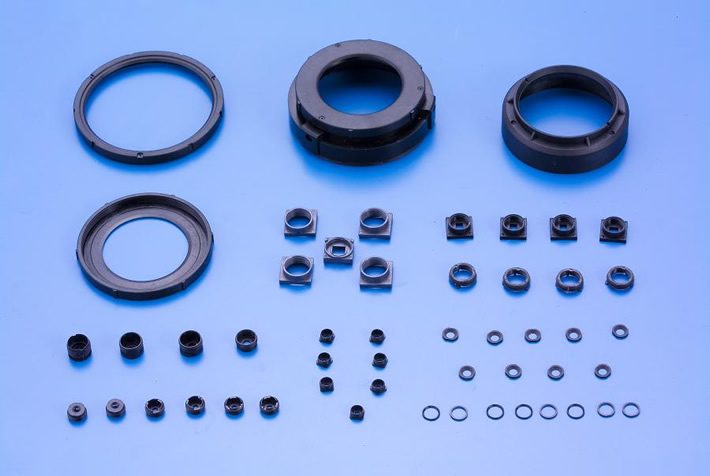Optical Precision Plastic

Application:
Optical Market – Lens Holder & Barrel for Mobile phone, Notebook, Monitor, Projector, Camera, Precision Plastic.
The injection department is 100% In-House tooling which provides speed-to-market advantage. MING-LI supplies the best quality optical parts to our valuable customers all over the world. Furthermore, our optical molding components are well-suited not only to the optical, but also the Electronic, Aerospace and Telecommunication industries.
-
In-house CPK Rate :≧ 1.33
-
Tolerance Range :Up to +/-0.003mm
-
Mold Size :500L*500W*500H ; up to 1,000kgs
-
Monthly Capacity :15 sets / Dies ; 13.8million pcs / Overmolding & Injection parts
Product Material
-
Plastic Parts :PC, ABS, PPA, PBT, PET, PPS, POM, Nylon PA, PA6, PA66, PA9T, LCP, Derlin, Acrylic, etc.
-
Special Material :PEEK
Key elements for plastic injection optiacl part molding
Producing high-quality plastic injection-molded optical parts requires attention to various key elements to ensure precise optics, clarity, and consistency. Here are the key elements for plastic injection molding of optical parts:
-
Material Selection: Choose optical-grade polymers suitable for the desired optical properties, such as clarity, transparency, refractive index, and UV stability. Common materials include PMMA (acrylic), PC (polycarbonate), COC (cyclic olefin copolymer), and PS (polystyrene).
-
Mold Design and Fabrication: Design molds with precision to replicate intricate optical surfaces and features accurately. Consider factors such as gate placement, cooling channels, venting, and part ejection to minimize defects and optimize part quality.
-
Surface Finish and Texture: Achieve the required optical surface finish and texture by polishing or texturing mold cavities appropriately. Smooth surfaces and optical-grade finishes are essential to minimize light scattering, distortion, and haze.
-
Injection Molding Process Optimization: Optimize injection molding parameters such as melt temperature, injection speed, packing pressure, and cooling time to achieve complete filling of the mold cavity, uniform part density, and minimal residual stresses. Implement scientific molding techniques for precise control and consistency.
-
Tooling Maintenance and Inspection: Regularly maintain and inspect molds to ensure proper alignment, surface condition, and functionality. Preventive maintenance helps minimize defects and prolong mold life, ensuring consistent part quality over time.
-
Quality Control Measures: Implement rigorous quality control measures throughout the manufacturing process. Conduct inspections of raw materials, in-process checks, and post-molding inspections to detect and address defects such as bubbles, flow lines, warpage, and surface imperfections.
-
Optical Testing and Validation: Perform optical testing and validation to assess part performance and adherence to specifications. Use techniques such as spectrophotometry, surface profilometry, and scatterometry to evaluate optical properties such as transmission, haze, clarity, and surface roughness.
-
Handling and Packaging: Handle optical parts carefully to prevent scratching, contamination, or damage to optical surfaces. Use cleanroom environments and protective packaging materials to maintain optical clarity and cleanliness during storage and transportation.
-
Environmental Control: Maintain environmental conditions such as temperature, humidity, and dust levels to minimize the risk of defects and contamination during molding and handling of optical parts. Control ambient conditions within production facilities and storage areas to preserve optical quality.
-
Regulatory Compliance: Ensure compliance with industry standards and regulations applicable to optical components, such as ISO 10110 for optical drawings and specifications, RoHS for restricted substances, and ASTM standards for optical testing methods.
By addressing these key elements with precision and attention to detail, you can optimize the plastic injection molding process for producing high-quality optical parts with consistent optical performance and clarity. Collaboration with experienced engineers, mold designers, and manufacturers specializing in optical molding can also provide valuable expertise and support in achieving optimal results.
What should be cared for plastic optical part design?
Designing plastic optical parts requires careful consideration of various factors to ensure optimal performance and functionality. Here are some key aspects to consider when designing plastic optical parts:
-
Material Selection:
- Choose a transparent or translucent plastic material with excellent optical properties, such as high light transmission, low birefringence, and minimal color distortion.
- Common materials include acrylic (PMMA), polycarbonate (PC), styrene (PS), and various optical-grade polymers.
-
Optical Performance:
- Define the optical requirements of the part, including factors such as clarity, light transmission, refractive index, and dispersion.
- Optimize the design to minimize optical aberrations such as distortion, chromatic aberration, and spherical aberration.
-
Surface Quality:
- Design optical surfaces with smoothness and precision to minimize scattering, reflection, and other forms of light distortion.
- Specify surface finish requirements, such as polish level or roughness, to achieve the desired optical clarity and performance.
-
Geometric Accuracy:
- Ensure dimensional accuracy and geometric precision to maintain optical alignment and functionality.
- Design features such as lenses, prisms, and mirrors with precise shapes, profiles, and angles to achieve the desired optical effects.
-
Mechanical Stability:
- Design the part with sufficient mechanical strength and stability to withstand handling, assembly, and environmental conditions.
- Consider factors such as wall thickness, ribbing, and reinforcement to prevent warping, distortion, or mechanical failure.
-
Tolerance Control:
- Specify tight tolerances for critical dimensions and optical surfaces to ensure consistent performance and alignment.
- Consider the effects of material shrinkage, thermal expansion, and molding variability on dimensional accuracy and tolerances.
-
Moldability:
- Design the part for manufacturability using injection molding processes, considering factors such as draft angles, undercuts, and parting lines.
- Optimize the mold design, gating system, and cooling channels to minimize defects such as flow marks, sink marks, and bubbles.
-
Light Management:
- Incorporate features such as light guides, diffusers, or reflectors to control light distribution, diffusion, or redirection as needed.
- Design optical elements with appropriate shapes and configurations to achieve desired light output patterns or effects.
-
Environmental Considerations:
- Evaluate the impact of environmental factors such as temperature, humidity, and UV exposure on optical performance and material stability.
- Select materials and design features that can withstand the intended operating conditions over the lifetime of the part.
-
Testing and Validation:
- Conduct thorough testing and validation of the optical part design through prototyping and optical testing.
- Use techniques such as interferometry, spectrophotometry, or optical imaging to assess optical performance, clarity, and alignment.
By addressing these considerations during the design phase, you can optimize the performance, manufacturability, and reliability of plastic optical parts for a wide range of applications, including lenses, light guides, displays, sensors, and imaging systems. Collaboration with experienced optical engineers and manufacturers can also provide valuable insights and expertise in achieving successful optical part designs.
What must be cared for plastic injection optical parts measurement?
When measuring plastic injection optical parts, several considerations must be taken into account to ensure accuracy and reliability. Here are some key aspects to consider:
-
Dimensional Accuracy:
- Measure critical dimensions such as overall size, thickness, and optical surface profiles accurately using precise measurement tools such as calipers, micrometers, or optical comparators.
- Ensure that measurements are taken at multiple locations on the part to account for potential variations caused by the injection molding process.
-
Surface Finish and Texture:
- Assess the surface finish and texture of optical surfaces using appropriate measurement techniques such as surface roughness testers or interferometers.
- Verify that the surface finish meets specified requirements for optical clarity and smoothness.
-
Optical Performance:
- Use optical testing equipment such as spectrophotometers, goniometers, or interferometers to evaluate optical properties such as light transmission, reflectance, and aberrations.
- Perform tests to assess factors such as clarity, distortion, and chromatic aberration to ensure compliance with design specifications.
-
Geometric Features:
- Measure geometric features such as lens profiles, angles, and curvature accurately using optical profilometers or coordinate measuring machines (CMMs).
- Verify that critical geometrical parameters meet design requirements to ensure proper optical performance.
-
Tolerance Verification:
- Verify dimensional tolerances and form deviations against design specifications to ensure that the part meets required tolerances.
- Use statistical analysis techniques such as capability studies or process control charts to monitor and control dimensional variation during production.
-
Environmental Conditions:
- Conduct measurements under controlled environmental conditions to minimize the effects of temperature, humidity, and vibration on measurement accuracy.
- Consider the impact of environmental factors on optical properties such as refractive index and material stability.
-
Calibration and Traceability:
- Ensure that measurement instruments are properly calibrated and maintained according to industry standards.
- Maintain records of calibration certificates and traceability to ensure the accuracy and reliability of measurement results.
-
Documentation and Reporting:
- Document measurement results, including detailed reports of dimensional measurements, surface finish data, and optical performance tests.
- Provide comprehensive documentation for traceability and quality assurance purposes.
-
Statistical Analysis:
- Use statistical analysis techniques such as process capability analysis or Six Sigma methodologies to assess measurement variability and process stability.
- Identify and address sources of variation that may affect measurement accuracy or part quality.
-
Verification against Design Intent:
- Compare measurement results against design specifications and performance requirements to ensure that the part meets intended functionality and performance criteria.
- Conduct validation testing or performance evaluation to confirm that the optical part performs as expected under real-world conditions.
By paying attention to these considerations and employing appropriate measurement techniques and tools, you can ensure the accurate assessment of plastic injection optical parts and maintain high quality and consistency in production.



